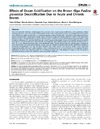Please use this identifier to cite or link to this item:
https://accedacris.ulpgc.es/handle/10553/47958
| DC Field | Value | Language |
|---|---|---|
| dc.contributor.author | Gil-Díaz, Teba | en_US |
| dc.contributor.author | Haroun, Ricardo | en_US |
| dc.contributor.author | Tuya, Fernando | en_US |
| dc.contributor.author | Viera-Rodríguez, María A. | en_US |
| dc.contributor.author | Betancor Curbelo, Séfora | en_US |
| dc.date.accessioned | 2018-11-23T17:49:24Z | - |
| dc.date.available | 2018-11-23T17:49:24Z | - |
| dc.date.issued | 2014 | en_US |
| dc.identifier.issn | 1932-6203 | en_US |
| dc.identifier.uri | https://accedacris.ulpgc.es/handle/10553/47958 | - |
| dc.description.abstract | Since the industrial revolution, anthropogenic CO2 emissions have caused ocean acidification, which particularly affects calcified organisms. Given the fan-like calcified fronds of the brown alga Padina pavonica, we evaluated the acute (shortterm) effects of a sudden pH drop due to a submarine volcanic eruption (October 2011-early March 2012) affecting offshore waters around El Hierro Island (Canary Islands, Spain). We further studied the chronic (long-term) effects of the continuous decrease in pH in the last decades around the Canarian waters. In both the observational and retrospective studies (using herbarium collections of P. pavonica thalli from the overall Canarian Archipelago), the percent of surface calcium carbonate coverage of P. pavonica thalli were contrasted with oceanographic data collected either in situ (volcanic eruption event) or from the ESTOC marine observatory data series (herbarium study). Results showed that this calcified alga is sensitive to acute and chronic environmental pH changes. In both cases, pH changes predicted surface thallus calcification, including a progressive decalcification over the last three decades. This result concurs with previous studies where calcareous organisms decalcify under more acidic conditions. Hence, Padina pavonica can be implemented as a bio-indicator of ocean acidification (at short and long time scales) for monitoring purposes over wide geographic ranges, as this macroalga is affected and thrives (unlike strict calcifiers) under more acidic conditions | en_US |
| dc.format | application/pdf | - |
| dc.language | eng | en_US |
| dc.relation | Respuesta de la Bota Intermareal A Perturbaciones Humanas: Efecto de la Eutrofización en El Marco Del Actual Contexto Climático. | en_US |
| dc.relation | Status Ecologico y Vulnerabilidad de Ecosistemas Marinos Canarios Al Cambio Climatico: Indicadores Funcionales y Respuesta Adaptativa Al Stress. | en_US |
| dc.relation.ispartof | PLoS ONE | en_US |
| dc.rights | by-nc-nd | - |
| dc.source | PLoS ONE [ISSN 1932-6203], v. 9 (9), art. e108630, (Septiembre 2014) | en_US |
| dc.subject | 241705 Biología marina | en_US |
| dc.title | Effects of ocean acidification on the brown alga "Padina pavonica": decalcification due to acute and chronic events | en_US |
| dc.type | info:eu-repo/semantics/Article | en_US |
| dc.type | Article | en_US |
| dc.identifier.doi | 10.1371/journal.pone.0108630 | en_US |
| dc.identifier.scopus | 84907494199 | - |
| dc.identifier.scopus | 2-s2.0-84907494199 | - |
| dc.identifier.isi | 000343671700129 | - |
| dc.contributor.authorscopusid | 55993934000 | - |
| dc.contributor.authorscopusid | 6603827643 | - |
| dc.contributor.authorscopusid | 6603608107 | - |
| dc.contributor.authorscopusid | 55993874300 | - |
| dc.contributor.authorscopusid | 6504450075 | - |
| dc.identifier.absysnet | 703406 | - |
| dc.identifier.issue | e108630 | - |
| dc.relation.volume | 9 | en_US |
| dc.investigacion | Ciencias | en_US |
| dc.rights.accessrights | info:eu-repo/semantics/openAccess | - |
| dc.type2 | Artículo | en_US |
| dc.utils.revision | Sí | en_US |
| dc.date.coverdate | Septiembre 2014 | en_US |
| dc.identifier.ulpgc | Sí | en_US |
| dc.contributor.buulpgc | BU-BAS | en_US |
| dc.description.sjr | 1,545 | |
| dc.description.jcr | 3,234 | |
| dc.description.sjrq | Q1 | |
| dc.description.jcrq | Q1 | |
| dc.description.scie | SCIE | |
| dc.description.erihplus | ERIH PLUS | |
| item.grantfulltext | open | - |
| item.fulltext | Con texto completo | - |
| crisitem.project.principalinvestigator | Tuya Cortés, Fernando José | - |
| crisitem.project.principalinvestigator | Haroun Tabraue, Ricardo Jesús | - |
| crisitem.author.dept | GIR ECOAQUA: Biodiversidad y Conservación | - |
| crisitem.author.dept | IU de Investigación en Acuicultura Sostenible y Ec | - |
| crisitem.author.dept | Departamento de Biología | - |
| crisitem.author.dept | GIR ECOAQUA: Biodiversidad y Conservación | - |
| crisitem.author.dept | IU de Investigación en Acuicultura Sostenible y Ec | - |
| crisitem.author.dept | Departamento de Biología | - |
| crisitem.author.dept | GIR ECOAQUA: Ecofisiología de Organismos Marinos | - |
| crisitem.author.dept | IU de Investigación en Acuicultura Sostenible y Ec | - |
| crisitem.author.dept | GIR ECOAQUA: Ecofisiología de Organismos Marinos | - |
| crisitem.author.dept | IU de Investigación en Acuicultura Sostenible y Ec | - |
| crisitem.author.orcid | 0000-0003-1348-692X | - |
| crisitem.author.orcid | 0000-0001-8316-5887 | - |
| crisitem.author.orcid | 0000-0002-6423-619X | - |
| crisitem.author.orcid | 0000-0002-6423-619X | - |
| crisitem.author.parentorg | IU de Investigación en Acuicultura Sostenible y Ec | - |
| crisitem.author.parentorg | IU de Investigación en Acuicultura Sostenible y Ec | - |
| crisitem.author.parentorg | IU de Investigación en Acuicultura Sostenible y Ec | - |
| crisitem.author.parentorg | IU de Investigación en Acuicultura Sostenible y Ec | - |
| crisitem.author.fullName | Haroun Tabraue, Ricardo Jesús | - |
| crisitem.author.fullName | Tuya Cortés, Fernando José | - |
| crisitem.author.fullName | Viera Rodríguez,María Ascensión | - |
| crisitem.author.fullName | Viera Rodríguez,María Ascensión | - |
| Appears in Collections: | Artículos | |
SCOPUSTM
Citations
15
checked on Jun 8, 2025
WEB OF SCIENCETM
Citations
12
checked on Jun 8, 2025
Page view(s)
71
checked on Aug 3, 2024
Download(s)
59
checked on Aug 3, 2024
Google ScholarTM
Check
Altmetric
Share
Export metadata
Items in accedaCRIS are protected by copyright, with all rights reserved, unless otherwise indicated.
